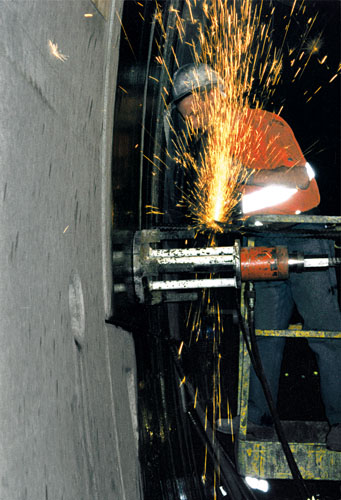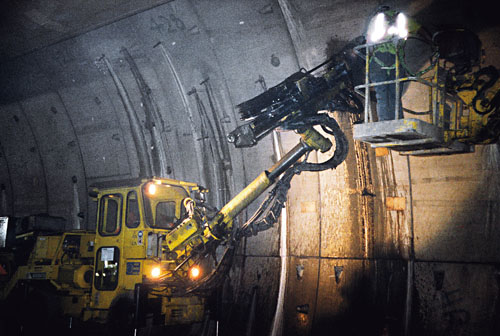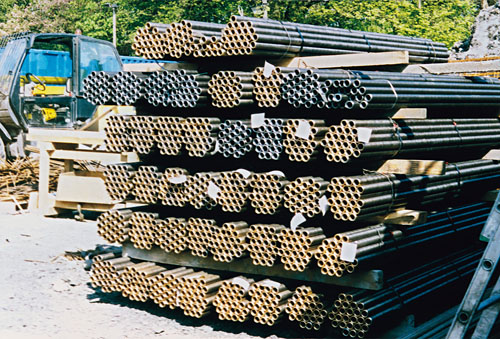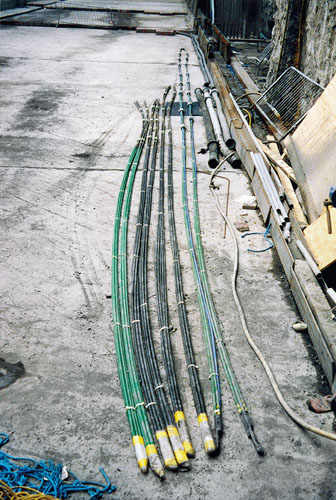



Dublin Port Tunnel
The booming economy in Ireland has lead to increases in traffic volumes throughout the country, but these have become particularly acute in Dublin causing major congestion problems throughout the city.
To ease congestion,the Dublin Port Tunnel was commissioned to provide a road link from the M1 Motorway in the north of Dublin City to the sea port, where the new road is intended to take the bulk of freight traffic direct from the sea port on to the Motorway Network (M1 and M50).
The project comprises of a twin bore tunnel (diameter 11.8m), to accommodate both north and southbound carriageways, over a length of 2.6km with an additional 1.9km of cut and cover tunnel at the northern approach.
DSI Products Supplied
DSI UK supplied products to four major areas within the tunnel project, as follows:
- Self-Drilling Hollow Bar Spiles - Launch Adit, Fairview Park This section of the tunnel was in difficult ground, featuring broken rock (hard limestone) overlaid by boulder clay.The launch adit was constructed as an extension to the turnaround chamber used by the TBM (Tunnel Boring Machine). The launch adit enabled the TBM to be reassembled, following turnaround, to its operating configuration (length = 100m) prior to boring for the start of the northbound drive.The two drilling methods used for the installation of the inclined Spiles were:
- Simultaneous drill and grout (in conjunction with a stuffing box at the mouth of the borehole)
- Water flush drilling, followed by subsequent grout injection through the bore of the bar.
- Strand Anchors and Multi-Stage Strand Anchors - TBM Shove Frames The strand anchors were used to restrain the shove frames at both ends of the tunnels during launching (Collins Avenue and Fairview Park). The shove frame at the Fairview Park end of the southbound tunnel required some specialist anchors as the ground conditions varied between the crown level and invert level of the tunnel.The ground conditions at the crown were weak ground requiring 15m bond lengths, this could only be achieved through the use of DSI Multi-Stage Anchors. At the lower levels,conventional DSI Strand anchors were sufficient.Following installation of the anchors, DSI UK provided a crew of stressing technicians to proof test the anchors and then lock-off each anchor at the required working load.
- Prestressing Steel Rock Bolts with Grout Packers - Lay-by Enlargements, Cross-Over Tunnels. Following the boring of both tunnels, there was a considerable package of rock bolting required, for roof and rib (sidewall) support,in the secondary stage of tunnelling works comprising of:
- Lay-by enlargements (4 pcs.at 50 m each).The lay-by enlargements comprise of localised enlargement of the tunnel bore to provide parking spaces,outside of the main carriageway,for broken down vehicles.
- Cross passages between the tunnel bores (at every 250m centres),to provide escape routes for motorists (in case of fire), as well as access for service and maintenance crews.In addition,there are also two vehicle cross passages.
- Formtie System -Permanent Tunnel Lining Plinths (Both Tunnels)Following the construction of the primary segmental lining through both tunnels, a permanent (waterproofed) concrete lining was required over the full length of each tunnel. The permanent concrete lining required a cast concrete plinth, formed at invert level,on both sides of the two tunnels. The formwork for the concrete plinths was restrained using 20mm removable DSI Formties, anchored into the segmental lining of the tunnel using expansion shells. The front shutter was stiffened with a standard waler beam detail, held in place with DSI Waler Plates and Wingnuts.
The official opening of the tunnel is scheduled for summer 2005.
